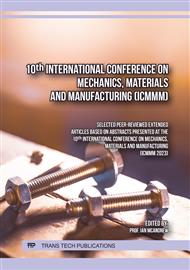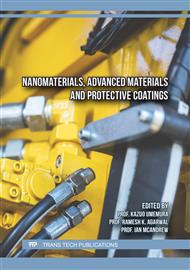[1]
O. Schauerte, "Titanium in Automotive Production," Adv. Eng. Mater., vol. 5, no. 6, p.411–418, Jun. 2003.
DOI: 10.1002/adem.200310094
Google Scholar
[2]
D. A. Stephenson and J. S. Agapiou, Metal cutting theory and practice. CRC press, 2016.
Google Scholar
[3]
C. Sateesh Kumar, H. Majumder, A. Khan, and S. K. Patel, "Applicability of DLC and WC/C low friction coatings on Al2O3/TiCN mixed ceramic cutting tools for dry machining of hardened 52100 steel," Ceram. Int., vol. 46, no. 8, p.11889–11897, Jun. 2020.
DOI: 10.1016/j.ceramint.2020.01.225
Google Scholar
[4]
S. Dutta and S. K. R. Narala, "Investigations on chip formation of turned novel AM alloy," Proc. Inst. Mech. Eng. Part E J. Process Mech. Eng., vol. 235, no. 2, p.332–341, 2021.
DOI: 10.1177/0954408920961196
Google Scholar
[5]
S. Zhang, J. Li, X. Zhu, and H. Lv, "Saw-tooth chip formation and its effect on cutting force fluctuation in turning of Inconel 718," Int. J. Precis. Eng. Manuf., vol. 14, no. 6, p.957–963, 2013.
DOI: 10.1007/s12541-013-0126-7
Google Scholar
[6]
T. Kitagawa, A. Kubo, and K. Maekawa, "Temperature and wear of cutting tools in high-speed machining of Inconel 718 and Ti 6Al 6V2Sn," wear, vol. 202, no. 2, p.142–148, 1997.
DOI: 10.1016/s0043-1648(96)07255-9
Google Scholar
[7]
H. Ren and Y. Altintas, "Mechanics of machining with chamfered tools," J. Manuf. Sci. Eng., vol. 122, no. 4, p.650–659, 2000.
DOI: 10.1115/1.1286368
Google Scholar
[8]
T. C. Hsu, "A study of the normal and shear stresses on a cutting tool," 1966.
Google Scholar
[9]
N. R. Dhar, N. Sarmin, K. Paul, N. Nahar, and D. Alam, "Chip Formation in Turning Medium Carbon Steel by Uncoated Carbide Inserts under Dry, Wet and High-Pressure Coolant Conditions," in International Conference on Mwchanical Engineering 2007, 2007, p.29–31.
Google Scholar
[10]
R. Suresh, S. Basavarajappa, V. N. Gaitonde, and G. L. Samuel, "Machinability investigations on hardened AISI 4340 steel using coated carbide insert," Int. J. Refract. Met. Hard Mater., vol. 33, p.75–86, 2012.
DOI: 10.1016/j.ijrmhm.2012.02.019
Google Scholar
[11]
M. Stanford, P. M. Lister, C. Morgan, and K. A. Kibble, "Investigation into the use of gaseous and liquid nitrogen as a cutting fluid when turning BS 970-80A15 (En32b) plain carbon steel using WC–Co uncoated tooling," J. Mater. Process. Technol., vol. 209, no. 2, p.961–972, 2009.
DOI: 10.1016/j.jmatprotec.2008.03.003
Google Scholar
[12]
R. M. Mendieta and J. de D. Calderón Nájera, "Analysis of MQL effect on forces, friction, and surface roughness in turning of AISI 4140 steel," in International Manufacturing Science and Engineering Conference, 2018, vol. 51388, p. V004T03A048.
DOI: 10.1115/msec2018-6344
Google Scholar
[13]
Singh G, Aggarwal V, Singh S, Experimental investigations into machining performance of Hastelloy C-276 in different cooling environments, Material and Manufacturing Processes, 2021
DOI: 10.1080/10426914.2021.1945099
Google Scholar
[14]
A. K. Sahoo and S. Pradhan, "Modeling and optimization of Al/SiCp MMC machining using Taguchi approach," Meas. J. Int. Meas. Confed., vol. 46, no. 9, p.3064–3072, 2013.
DOI: 10.1016/j.measurement.2013.06.001
Google Scholar
[15]
C. Camposeco-Negrete, "Optimization of cutting parameters for minimizing energy consumption in turning of AISI 6061 T6 using Taguchi methodology and ANOVA," J. Clean. Prod., vol. 53, p.195–203, 2013.
DOI: 10.1016/j.jclepro.2013.03.049
Google Scholar
[16]
D. Philip Selvaraj, P. Chandramohan, and M. Mohanraj, "Optimization of surface roughness, cutting force and tool wear of nitrogen alloyed duplex stainless steel in a dry turning process using Taguchi method," Meas. J. Int. Meas. Confed., vol. 49, no. 1, p.205–215, 2014.
DOI: 10.1016/j.measurement.2013.11.037
Google Scholar
[17]
Dureja, J.S., Singh, R. and Bhatti, M.S.. Optimizing flank wear and surface roughness during hard turning of AISI D3 steel by Taguchi and RSM methods. Production & Manufacturing Research, 2(1), pp.767-783, 2014.
DOI: 10.1080/21693277.2014.955216
Google Scholar
[18]
Sarıkaya, M. and Güllü, A. Taguchi design and response surface methodology based analysis of machining parameters in CNC turning under MQL. J. Clean. Prod., 65, pp.604-616, 2014.
DOI: 10.1016/j.jclepro.2013.08.040
Google Scholar
[19]
S. Debnath, M. Mohan Reddy, and Q. Sok Yi, "Influence of cutting fluid conditions and cutting parameters on surface roughness and tool wear in turning process using Taguchi method," Measurement, vol. 78, p.111–119, 2016.
DOI: 10.1016/j.measurement.2015.09.011
Google Scholar
[20]
D. Manivel and R. Gandhinathan, "Optimization of surface roughness and tool wear in hard turning of austempered ductile iron (grade 3) using Taguchi method," Meas. J. Int. Meas. Confed., vol. 93, no. grade 3, p.108–116, 2016.
DOI: 10.1016/j.measurement.2016.06.055
Google Scholar
[21]
M. Mia and N. R. Dhar, "Optimization of surface roughness and cutting temperature in high-pressure coolant-assisted hard turning using Taguchi method," Int. J. Adv. Manuf. Technol., 88(1-4), pp.739-753, 2016.
DOI: 10.1007/s00170-016-8810-2
Google Scholar
[22]
V. Vijayaraghavan, A. Garg, L. Gao, R. Vijayaraghavan, and G. Lu, "A finite element based data analytics approach for modeling turning process of Inconel 718 alloys," J. Clean. Prod., 137, pp.1619-1627. 2016.
DOI: 10.1016/j.jclepro.2016.04.010
Google Scholar
[23]
M. K. Gupta, P. K. Sood, and V. S. Sharma, "Optimization of machining parameters and cutting fluids during nano-fluid based minimum quantity lubrication turning of titanium alloy by using evolutionary techniques," J. Clean. Prod., 135, pp.1276-1288. 2016.
DOI: 10.1016/j.jclepro.2023.136193
Google Scholar
[24]
P. Sivaiah and D. Chakradhar, "Analysis and Modeling of Cryogenic Turning Operation Using Response Surface Methodology," Silicon, (2018)
DOI: 10.1007/s12633-018-9816-1
Google Scholar
[25]
Babu, M. Naresh, V. Anandan, Çağrı Vakkas Yıldırım, M. Dinesh Babu, and Murat Sarıkaya. "Investigation of the characteristic properties of graphene-based nanofluid and its effect on the turning performance of Hastelloy C276 alloy." Wear 510 (2022): 204495.
DOI: 10.1016/j.wear.2022.204495
Google Scholar
[26]
Singh, Gurpreet, Vivek Aggarwal, Sehijpal Singh, and Balkar Singh. "Sustainable machining of Hastelloy C-276 enabling minimum quantity lubrication of environmentally compatible lubricants." Journal of Cleaner Production 373 (2022): 133928.
DOI: 10.1016/j.jclepro.2022.133928
Google Scholar
[27]
Singh, G., Aggarwal, V., Singh, S., Singh, B., Sharma, S., Singh, J., & Mohamed, A. (2022). Experimental Investigation and Performance Optimization during Machining of Hastelloy C-276 Using Green Lubricants. Materials, 15(15), 5451.
DOI: 10.3390/ma15155451
Google Scholar
[28]
Singh, G., Aggarwal, V., & Singh, S. (2020). Critical review on ecological, economical and technological aspects of minimum quantity lubrication towards sustainable machining. Journal of Cleaner Production, 271, 122185.
DOI: 10.1016/j.jclepro.2020.122185
Google Scholar



